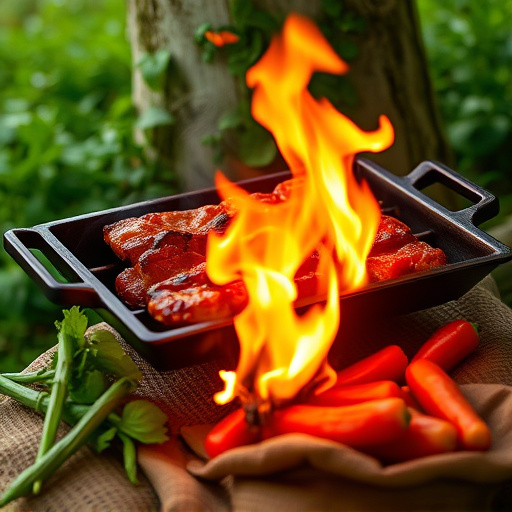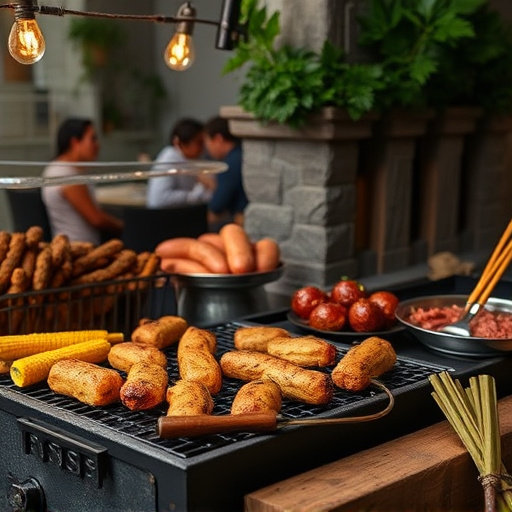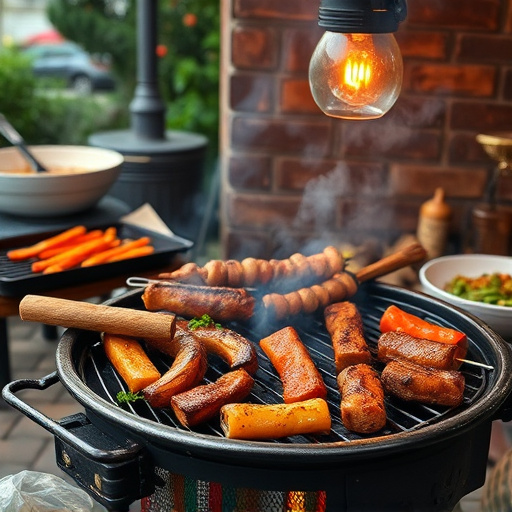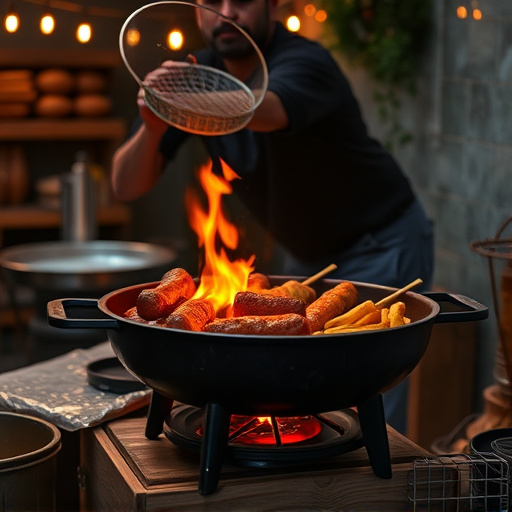Cooking a perfect BBQ ham involves using "low and slow" techniques to transform tough cuts of meat into tender, juicy treats. Choose bone-in hams with good fat content for optimal results. Use dry brining to enhance flavor without drying out the ham. Smoke the ham gently over indirect heat between 200-225°F (93-107°C) for extended periods, breaking down connective tissues and infusing smoky flavors. Season with a dry rub and apply tangy BBQ sauce during cooking for depth of flavor. Maintain consistent temperature, use quality hams, and avoid overcooking or heavy basting for best results.
Unleash the mouthwatering aroma of a perfect BBQ ham with the low and slow cooking method. This technique transforms a simple cut of meat into a juicy, flavorful delight. In this comprehensive guide, we’ll walk you through every step, from understanding the art of low-and-slow to mastering dry brining, smoking, and seasoning. Discover the secrets to achieving a tender, smoky BBQ ham that’s sure to impress, making it your go-to recipe for any gathering.
- Understanding the Low and Slow Technique
- Selecting the Perfect Ham for BBQ
- Dry Brining for Maximum Flavor
- The Art of Smoking at Low Temperatures
- Seasoning and Sauce: Enhancing the Taste
- Tips for Success and Common Mistakes to Avoid
Understanding the Low and Slow Technique

The “low and slow” cooking technique is a time-honored method for transforming tough cuts of meat into tender, juicy delights—perfect for a mouthwatering BBQ ham recipe. This approach involves cooking meat at low temperatures (typically below 200°F/93°C) for an extended period. The key to success lies in patience; the slow process allows collagen in the meat to break down, resulting in incredibly tender, flavorful ham.
This technique is ideal for larger cuts of pork like a whole leg or shoulder, ensuring every bite is jam-packed with deliciousness. By maintaining a consistent low temperature, the ham cooks evenly, locking in juices and creating a moist, tender end product that’s sure to impress at any BBQ gathering.
Selecting the Perfect Ham for BBQ

When it comes to a mouthwatering BBQ ham recipe, choosing the right cut is key. Look for a bone-in ham with a good layer of fat – this ensures juicy results when slow-cooked. Opt for a ham with a pinkish-red color and a slightly firm texture; these are signs of freshness. Avoid pre-sliced hams as they tend to dry out more quickly during the cooking process.
The ideal BBQ ham should have a natural marbling, which means the fat is evenly distributed throughout the meat, providing both flavor and moisture. Consider a heritage or artisan ham if you can find one; these often have unique flavors and are raised with care, resulting in superior quality. Remember, the better the quality of your ham, the more delicious your final dish will be!
Dry Brining for Maximum Flavor

Dry brining is a technique that enhances the flavor and moisture content of your BBQ ham recipe, resulting in a juicy and tender end product. This method involves rubbing the ham with coarse salt before leaving it to sit for several days. The salt draws out moisture from the meat, creating a vacuum that allows flavorful brines and spices to penetrate deeper into the ham’s fibers.
Unlike wet brining, which requires soaking the ham in a salty liquid, dry brining relies on the physical process of osmosis. This makes it an ideal choice for those who prefer a straightforward approach without the need for constant monitoring or additional ingredients. By simply massaging salt into the ham and leaving it to rest, you can achieve remarkable results that will impress your taste buds.
The Art of Smoking at Low Temperatures

The art of smoking ham at low and slow temperatures is a delicate dance, often referred to as the BBQ ham recipe. This method involves gently cooking the ham over indirect heat, typically around 200-225°F (93-107°C), for an extended period. The low temperature allows for a gradual breakdown of connective tissues, making the ham incredibly tender and juicy. This slow process also infuses the meat with smoky flavors, creating a complex taste profile that’s hard to replicate using other cooking methods.
Smoking at low temperatures is not just about heat; it’s about time too. The longer the ham cooks, the more the flavors meld and deepen. This meticulous approach ensures that every bite of your BBQ ham recipe is packed with rich, savory notes, balanced by a subtle smokiness that lingers on the palate. It’s a method that requires patience, but the result—a melt-in-your-mouth ham with an irresistible smoky aroma—is well worth the wait.
Seasoning and Sauce: Enhancing the Taste

In the quest for a perfect BBQ ham recipe, seasoning and sauce play a pivotal role in enhancing the flavor and juiciness of the dish. The key is to start with a robust base of salt, pepper, garlic, and paprika, rubbing these dry rubs into the ham before it begins its slow cook. This initial step not only prepares the meat but also sets the stage for a complex, savory taste profile.
For an extra layer of deliciousness, a tangy BBQ sauce can be brushed onto the ham during the cooking process. A blend of ketchup, vinegar, brown sugar, and a touch of Worcestershire sauce creates a mouthwatering glaze that not only adds moisture but also deepens the overall flavor. The sauce can be adjusted to suit personal preferences, with some opting for a sweeter or spicier profile, ensuring each bite is an explosion of taste in this low and slow cooking method.
Tips for Success and Common Mistakes to Avoid

Tips for Success:
When cooking ham using the low and slow method, consistency is key. Maintain a steady temperature within your smoker or oven, aiming for around 225°F (107°C). This gradual cooking process allows the ham to retain its moisture, resulting in a juicy, tender end product. Use a good quality, well-marbled ham, and consider scoring the surface to promote even cooking and crisping. Keep an eye on the seasoning—a simple combination of salt, pepper, and brown sugar works wonders. For an extra flavor boost, infuse your smoker with wood chips or chunks, like hickory or applewood, which are popular choices for BBQ ham recipes.
Common Mistakes to Avoid:
One of the most common pitfalls is overcooking, which can dry out the ham. Be mindful of the cooking time and use a meat thermometer to check the internal temperature regularly. Another mistake is not controlling the temperature accurately, leading to inconsistent results. Always monitor and adjust as needed. Don’t be tempted to rush the process; this method requires patience. Lastly, avoid heavy basting, as it can add extra moisture that might delay the ham’s crisping. Remember, the key to a perfect BBQ ham recipe is time, temperature, and tender love—not rushing the natural, slow-cooking process.
